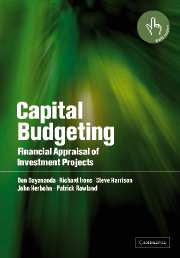Book contents
- Frontmatter
- Contents
- List of figures
- List of tables
- Preface
- 1 Capital budgeting: an overview
- 2 Project cash flows
- 3 Forecasting cash flows: quantitative techniques and routes
- 4 Forecasting cash flows: qualitative or judgemental techniques
- 5 Essential formulae in project appraisal
- 6 Project analysis under certainty
- 7 Project analysis under risk
- 8 Sensitivity and break-even analysis
- 9 Simulation concepts and methods
- 10 Case study in financial modelling and simulation of a forestry investment
- 11 Resource constraints and linear programming
- 12 More advanced linear programming concepts and methods
- 13 Financial modelling case study in forestry project evaluation
- 14 Property investment analysis
- 15 Forecasting and analysing risks in property investments
- 16 Multinational corporations and international project appraisal
- References
- Index
6 - Project analysis under certainty
Published online by Cambridge University Press: 14 May 2010
- Frontmatter
- Contents
- List of figures
- List of tables
- Preface
- 1 Capital budgeting: an overview
- 2 Project cash flows
- 3 Forecasting cash flows: quantitative techniques and routes
- 4 Forecasting cash flows: qualitative or judgemental techniques
- 5 Essential formulae in project appraisal
- 6 Project analysis under certainty
- 7 Project analysis under risk
- 8 Sensitivity and break-even analysis
- 9 Simulation concepts and methods
- 10 Case study in financial modelling and simulation of a forestry investment
- 11 Resource constraints and linear programming
- 12 More advanced linear programming concepts and methods
- 13 Financial modelling case study in forestry project evaluation
- 14 Property investment analysis
- 15 Forecasting and analysing risks in property investments
- 16 Multinational corporations and international project appraisal
- References
- Index
Summary
In the previous chapters, we have discussed the identification and estimation of project cash flows and illustrated the mathematical formulae essential for project evaluation. This chapter now uses these elements for investment analysis. There are two groups of project evaluation techniques: discounted cash flow (DCF) analysis and non-discounted cash flow (NDCF) analysis. The first group includes the net present value (NPV) and the internal rate of return (IRR). The second group includes the payback period (PP) and the accounting rate of return (ARR).
Generally, DCF analysis is preferred to NDCF analysis. Within DCF analysis, the theoretical and practical strengths of NPV and IRR differ. Theoretically, the NPV approach to project evaluation is superior to that of IRR. The NPV technique discounts all future project cash flows to the present day to see whether there is a net benefit or loss to the firm from investing in the project. If the NPV is positive, then the project will increase the wealth of the firm. If it is zero, then the project will return only the required rate of return, and will not increase the firm's wealth. If the NPV is negative, then the project will decrease the value of the firm and should be avoided.
In spite of the theoretical superiority of the NPV technique, project analysts and decision-makers sometimes prefer to use the IRR criterion. The preference for IRR is attributable to the general familiarity of managers and other business people with rates of return rather than with actual dollar returns (values).
- Type
- Chapter
- Information
- Capital BudgetingFinancial Appraisal of Investment Projects, pp. 91 - 113Publisher: Cambridge University PressPrint publication year: 2002



